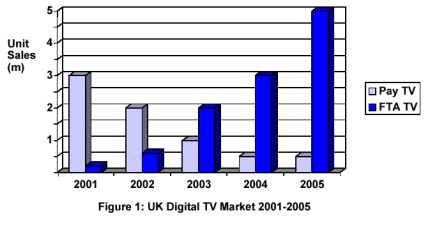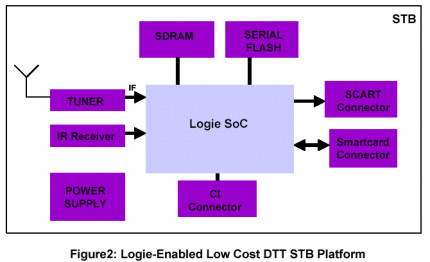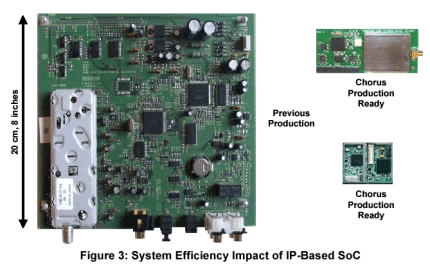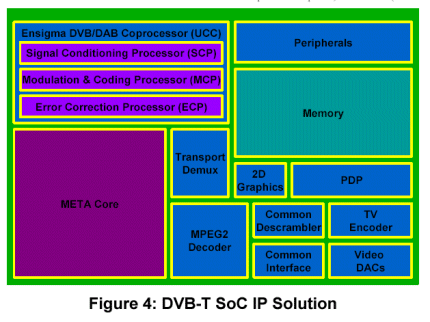by David McBrien,
Imagination Technologies Ltd.
London, United Kingdom
Abstract
Market requirements and support for Intellectual Property (IP) are constantly changing. Successful IP business models to date have been technology solutions based on one or more of the following: peripherals, international standards, processor cores and/or platforms.
Imagination Technologies (IMG) has taken the IP licensing concept one step further with the introduction of SoC-ready IP. This is a set of complementary IP deliverables addressing the needs of three fundamental functional requirements in an SoC, namely general purpose / DSP processing, wireless / baseband processing and graphics / video processing. In addition IMG provides peripheral modules to offer complete SoC solutions. This approach enables efficient and timely solutions addressing real-life system implementation issues within the consumer and communications markets.
This paper concentrates on a recently completed SoC-based solution for the DVB-T Free-to-Air (FTA) market, and also makes reference to previous examples of IMG success with similar IP.
Efficient Free-to-Air DVB-T System Solution Supported by IP-Based SoC Design
The Market Requirement
Frontier Silicon (Frontier) is a fabless semiconductor business whose core products include SoC devices for Digital TV (DTV), digital Radio and other emerging consumer multimedia products. Frontier's key markets include consumer electronics, automotive entertainment, set-top box (STB), PDA and mobile phone.
Frontier recognized the market opportunity for a highly-integrated SoC to support the emerging DVB-T market. This is a market which is set to grow significantly in the next few years so it was key for Frontier to be able to enter the market quickly and with a cost-effective solution. Figure 1 on the previous page illustrates that in the UK alone it is expected millions of DVB-T receivers will be sold over the next few years, particularly with the availability of a significantly higher number of FTA channels via digital terrestrial TV (DTT).

Frontier is a recent start-up. As such it’s success depends on being fast-moving in order to stay one step ahead of the major competition, including large semiconductor IDMs. Senior management at Frontier planned to develop a highly integrated SoC device that would enable significant STB cost down for the highly competitive FTA DTT market. At the same time the device was specified to include advanced functionality including DVD, DAB (Digital Audio Broadcast), PVR (Personal Video Record) and advanced multimedia, while keeping to the aggressive cost targets for the SoC.
Frontier does not have the design capability to independently develop such a device. They sought an IP partner who could provide them with the appropriate technology in a timely fashion and identified IMG as an ideal technology provider who also has the experience, know-how and resource to develop, integrate and validate complex SoCs.
Frontier had worked previously with IMG on a digital radio/audio product, a project that had resulted in a timely, cost effective and highly efficient system solution. Mass production DAB consumer products were in the shops within one year of the agreement between the companies. Due to SoC integration these appliances are being sold today at prices that are less than 40% of the best priced previous generation product, e.g. £99 DAB radio. The power of SoC has rekindled the digital radio market in Europe.
For the DTT project the goal was to develop and produce a device, codenamed Logie, that delivered on the benefits of System-on-Chip design. The SoC value proposition is that an ultra low cost DVB-T FTA STB can be developed by simply adding a PSU, a tuner, system memory, and a couple of digital TV connectors (see Figure 2 below).
Due to the level of integration achieved in the SoC, in addition to digital TV, Logie also supports PVR, DVD and home cinema applications, as well as advanced audio algorithms including surround sound and digital radio decoding.
Frontier enables timely solutions to market for their customers by offering complete RF /baseband modules. In addition system level and UI software is available for DTV and digital audio applications.

Background
Logie is based on IP technologies licensed from IMG including MPEG-2 decode, COFDM demodulation and the META multi-threaded processor core. IMG is a system IP licensing company with 2001 revenues that put it among the top 10 IP vendors worldwide. The company has a policy to support SoC-ready IP enabling customers to reach the market earlier so that the ever-shrinking market windows can be addressed with the latest innovative, state-of-the-art technology.
IMG has a proven track record in supporting system-level IP into SoC designs. One example of the impact of this is the DAB / audio device (Chorus) development and system software integration performed on behalf of Digital One. Figure 3 below illustrates the significant positive effect that system-level IP from IMG had in this case on the board size, assembly costs, development costs, power consumption and performance of the production DAB receiver.
All three technology divisions within IMG, namely Ensigma, PowerVR and Metagence, were involved in the Logie development, providing different parts of the functionality required. The fourth division of IMG, PURE Digital, an end product group, were instrumental in driving forward the digital radio market with the release of the first sub-£100 DAB receiver. Ensigma develops and licenses embedded DSP and hardware acceleration technology for entertainment and consumer electronics devices. Ensigma offers IP for communication and multimedia signal processing, combined with proven skills in the design and verification of real-time embedded systems.
Ensigma's IP is used worldwide in digital radio receivers, televisions, digital audio players, and wireless phones. For the Logie project Ensigma provided the front-end processing, the COFDM demodulation and error correction solutions. Ensigma also supplied the required audio algorithms, e.g. AC-3, DTS and DAB, for support on the embedded META processor.
PowerVR develops and licenses 2D/3D graphics and digital video cores for entertainment and consumer electronics devices. PowerVR technology is used in PCs, arcade machines, games consoles, digital STB, handheld devices and in-car information and entertainment systems. The 3D graphics technology is centred around PowerVR's unique tile-based rendering architecture which offers scalability and performance with unparalleled memory efficiency and image quality. For the Logie device PowerVR provided the complete video pipeline. This included the MPEG2 decoder, DVB Transport Demultiplexer, Common Descrambler and Common Interface, 2D graphics, Pixel Display Pipeline and TV Encoder, as well as various system peripherals. The PowerVR division was also responsible for the overall SoC integration.
Metagence produces and licenses a unique multi-threaded programmable DSP/general purpose IP core that allows real-time response while supporting efficient multi-function operation. Using true hardware multi-threading, the META family of processors delivers, in a unified architecture, general purpose processing, complex DSP and multimedia capabilities, real-time operation and low power consumption. These advanced capabilities make the META processor cores ideal for the advanced requirements of entertainment and communications products. In Logie, META was integrated as the system processor, handling system control and the UI. The OS runs on META, which currently supports Linux, Nucleus, ITRON and the proprietary preemptive MeOS. All of the audio processing is also run on the META processor.
With these IP technologies from IMG, the highly integrated device (Logie) illustrated on the next page (Figure 4) was developed and made available to Frontier Silicon to meet their end market requirements.

Implementation
The combination of COFDM demodulation, the META processor, the MPEG2 decoder and video pipeline, as well as system peripherals offers the most highly integrated solution available on the market today. In addition the solution is programmable enabling multi-function support and upgradability.
The Universal Communications Coprocessor (UCC) from Ensigma addresses the PHY layer of DVB-T COFDM demodulation. In the analysis phase of the design it became clear that the conventional industry approach to COFDM demodulation was wasteful both in terms of logic gates and RAM utilization. The UCC is structured to make optimum use of both computing resources and local RAM. In comparison with previously designed DVB-T COFDM demodulators the UCC-based demodulator achieves the same or better performance using only half as much local RAM as these other solutions. The programmability of the UCC enables the support of other applications including DAB.
The multi-threaded META core provides the DSP and general purpose computing resource within Logie, particularly handling the control of the UCC coprocessor, the applications software, the OS and UI (User Interface). A META core with 4 threads is implemented. The hardware scheduler ensures that local and global computing resources are allocated in the most optimum way. The patented hardware AMA (Automatic MIPS Allocation) guarantees the appropriate thread prioritization and that any real-time constraints are met, assuming that the overall required resource is available. This enables third party applications developers to work in isolation, knowing that there will be a painless system integration of their software.
The META processor offers a very efficient processing engine that replaces today’s multi-core solutions. Each thread can be considered to be a virtual processor. Logie has been designed with two DSP threads and two general-purpose threads. The unified architecture ensures the optimum system memory and cache architecture. META’s multi-threaded architecture hides system memory latency such that when one of the threads stalls, e.g. due to off-chip memory access, the hardware scheduler switches to another thread (the one with the highest priority and available system resource) on the next cycle.
The video pipeline includes support for the transport demultiplexer, MPEG2 SD (Standard Definition) TV decode, a small 2D graphics engine, the PDP (Pixel Display Pipeline) and TV encoder. The DVB Common Descrambler and Common Interface are also integrated.
The MPEG2 decoder from IMG also supports HD (High Definition) TV, but this is not a requirement today in the European market. The PDP supports up to 6 planes. The implementation in Logie has two planes (video and graphics) plus background, as well as a multi-phase fully programmable scaler, alpha blending and chroma keying. Analogue modules are integrated to support direct video and audio interfaces, IF sampling and an chip PLL. A full set of peripherals is included to ensure appropriate interfaces for the tuner control, memory, storage, audio and security.
IMG provides base software support including device drivers, the transport stream decoder, MPEG1 and MPEG2 (stereo) audio decoders, Dolby Pro-Logic II Surround Sound, DVD audio support and DAB. In addition to the software developed by IMG there are a number of third parties supporting application software on Logie, including DVB-T, DVD, MHEG5, PVR and Java. Nucleus, ITRON, Linux and IMG proprietary MeOS have already been ported to the META core. Software support for Logie will continue to proliferate as targeted development systems become available towards the end of 2002.

Future
The same base programmable architecture implemented in Logie is capable of supporting many other applications. IMG has a focus on the communications and consumer markets. Applications include Java, Multimedia Home Platform (MHP), multi-standard DTV and digital radio and home networking. It is clear form this that a Logie class device is capable of powering future home media servers and clients.
Conclusions
In the UK alone the DVB-T market is set to explode, with the new DTT package, Freeview, becoming available imminently. The consortium, including the BBC and Sky, will help drive forecasted sales of 2m in 2003, and more than a total of 25m over the next 5 years.
Due to the timely availability of the required IP and the state-of-the-art integration support from IMG, Frontier expects to deliver a super-integrated SoC solution for DTV applications during the fourth quarter of 2002. This will be less than one year from project inception.
STB cost to the consumer is a key driver for this market, and the decision of the UK government to switch off analogue signals completely. The collaboration between Frontier and IMG has resulted in a solution that has helped to change the consumer mindset that ‘DTV means Pay-TV’! This has been made possible via the implementation of an efficient IP-based SoC design.
